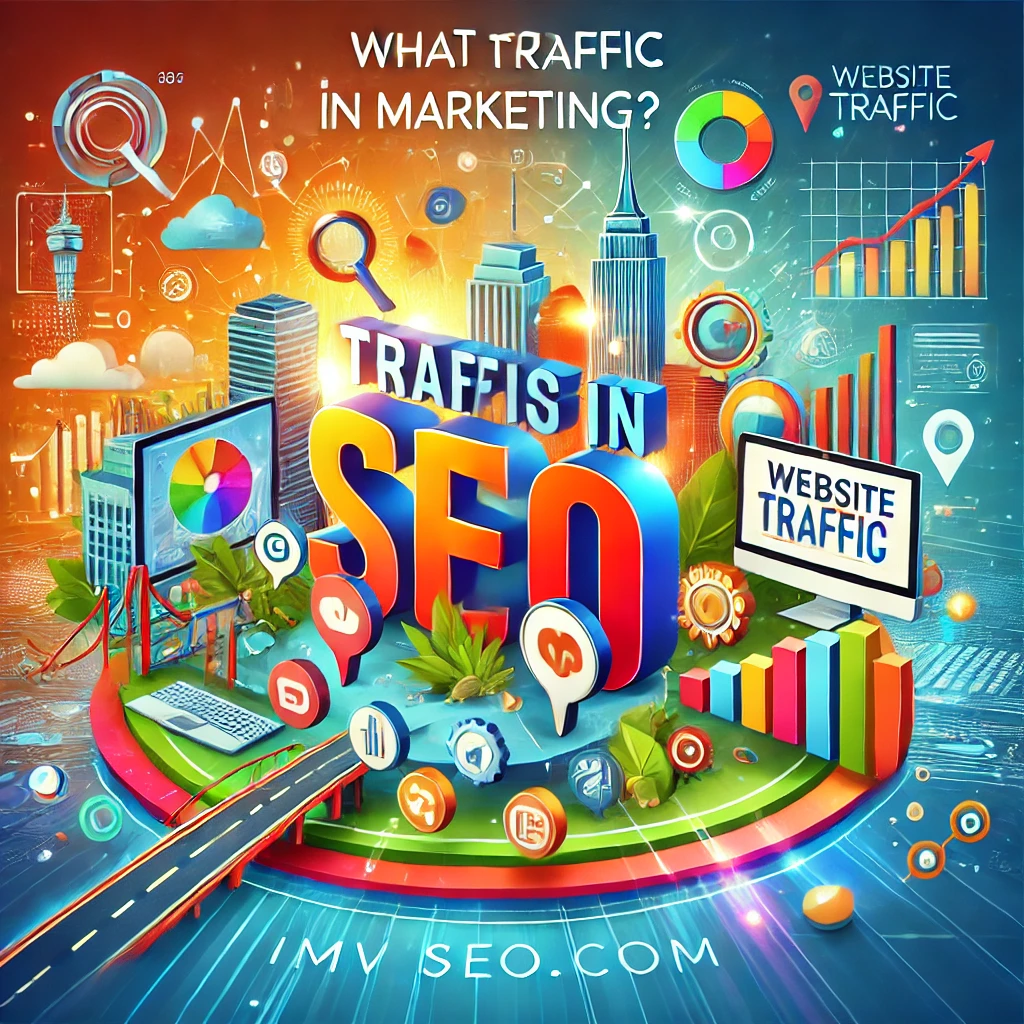In the digital marketing world, “traffic” is a term that frequently comes up. But what exactly is traffic in marketing, and why is it so crucial for your business’s success? Understanding traffic and how to effectively generate and analyze it can significantly impact your marketing strategy and overall business growth. In this comprehensive guide, we’ll explore what traffic in marketing is, the different types of traffic, and the best strategies to increase your website traffic.
Definition of Traffic in Marketing
Traffic Definition in Marketing
Traffic in marketing refers to the number of visitors who access a website. These visitors can come from various sources and can be categorized into different types of traffic, such as organic, paid, direct, referral, and social traffic. Each type of traffic has its own characteristics and requires different strategies to optimize.
Why Traffic Matters in Marketing
Measuring Success Through Traffic
Website traffic is a key indicator of your online presence and marketing effectiveness. High traffic levels often correlate with higher brand awareness, better customer engagement, and increased sales. By analyzing traffic, businesses can measure the success of their marketing efforts and make data-driven decisions to improve their strategies.
Types of Website Traffic
- Organic Traffic
Organic traffic comes from search engines like Google, Bing, and Yahoo. It is the result of users finding your website through unpaid search results. Optimizing your website for search engines (SEO) can significantly boost organic traffic.
- Paid Traffic
Paid traffic is generated through paid advertising campaigns, such as Google Ads, Facebook Ads, and other pay-per-click (PPC) platforms. This type of traffic can provide immediate results and is highly controllable.
- Direct Traffic
Direct traffic refers to visitors who access your website by typing your URL directly into their browser. This often indicates strong brand recognition and loyalty.
- Referral Traffic
Referral traffic occurs when visitors come to your website from other websites. This can happen through backlinks, mentions, or referral links from partners or affiliates.
- Social Traffic
Social traffic is generated from social media platforms like Facebook, Twitter, Instagram, LinkedIn, and Pinterest. This type of traffic is crucial for brand engagement and community building.
Sources of Traffic
- Search Engines
Search engines are a major source of traffic for many websites. By ranking high on search engine results pages (SERPs), businesses can attract a steady stream of organic traffic.
- Social Media Platforms
Social media platforms are powerful tools for driving traffic. Sharing content, engaging with followers, and running targeted ads can significantly increase social traffic.
- Email Marketing
Email marketing involves sending promotional messages to a list of subscribers. Effective email campaigns can drive traffic to your website and boost conversions.
- Referral Websites
Referral websites are those that link back to your site. High-quality backlinks from reputable sites can drive significant referral traffic and improve your SEO.
- Direct Visits
Direct visits come from users who already know your brand and type your URL directly into their browser. This type of traffic is often a sign of strong brand loyalty and awareness.
Strategies to Increase Website Traffic
- SEO (Search Engine Optimization)
SEO is one of the most effective strategies for increasing organic traffic. By optimizing your website’s content, structure, and technical aspects, you can improve your search engine rankings and attract more visitors.
- PPC (Pay-Per-Click) Advertising
PPC advertising allows you to bid on keywords and display ads to users searching for those terms. This can drive immediate traffic and is especially useful for targeting specific audiences.
- Content Marketing
Creating high-quality, valuable content is essential for attracting and retaining visitors. Content marketing involves producing blog posts, articles, videos, infographics, and other types of content that resonate with your audience.
- Social Media Marketing
Leveraging social media platforms to share content, engage with followers, and run ads can drive significant traffic to your website. Each platform has its own best practices and audience demographics.
- Email Marketing Campaigns
Building a strong email list and sending regular, engaging emails can drive traffic to your website. Personalized and targeted email campaigns tend to perform better and generate higher traffic.
SEO and Organic Traffic
- Importance of SEO for Organic Traffic
SEO is critical for driving organic traffic. By optimizing your website for search engines, you can improve your rankings, attract more visitors, and ultimately increase conversions.
- Techniques for SEO
Effective SEO techniques include keyword research, on-page optimization, technical SEO, link building, and creating high-quality content. These strategies work together to improve your website’s visibility in search results.
PPC and Paid Traffic
- Overview of PPC Advertising
PPC advertising involves paying for ads that appear on search engines, social media platforms, and other websites. Advertisers bid on keywords and pay each time someone clicks on their ad.
- Benefits of PPC
PPC offers several benefits, including immediate visibility, precise targeting, and measurable results. It allows businesses to reach specific audiences and adjust their campaigns based on performance data.
Content Marketing and Traffic Generation
- Creating High-Quality Content
High-quality content is essential for attracting and retaining website visitors. This includes blog posts, articles, videos, infographics, and other forms of content that provide value to your audience.
- Blogging and Guest Posting
Blogging regularly can drive traffic to your website and improve your SEO. Guest posting on other reputable websites can also bring in referral traffic and establish your authority in your industry.
Social Media Marketing and Traffic
- Leveraging Social Media for Traffic
Social media platforms are powerful tools for driving traffic. Sharing engaging content, interacting with followers, and running targeted ads can significantly boost your social traffic.
- Best Practices for Social Media Marketing
Effective social media marketing involves understanding your audience, posting regularly, using visuals, and engaging with your followers. Each platform has its own best practices and strategies for success.
seo services for security guard companies
Email Marketing and Traffic
- Building an Email List
Building a strong email list involves collecting email addresses from interested visitors. This can be done through sign-up forms, lead magnets, and other incentives.
- Effective Email Campaigns
Effective email campaigns are personalized, relevant, and engaging. They should provide value to the recipients and include clear calls-to-action that drive traffic to your website.
Analyzing and Measuring Traffic
- Key Metrics to Track
Key metrics to track for analyzing traffic include:
- Pageviews: The number of pages viewed by visitors.
- Unique Visitors: The number of distinct individuals visiting your website.
- Bounce Rate: The percentage of visitors who leave your site after viewing only one page.
- Average Session Duration: The average amount of time visitors spend on your site.
- Conversion Rate: The percentage of visitors who complete a desired action, such as making a purchase or filling out a form.
- Tools for Traffic Analysis
Several tools can help analyze and measure website traffic, including Google Analytics, SEMrush, Ahrefs, and Moz. These tools provide valuable insights into your traffic sources, visitor behavior, and overall performance.
SEO Agency Brighton IMVSEO.com: Boost Your Online Presence Today
Improving User Experience to Boost Traffic
- Website Design and Navigation
A well-designed website with easy navigation improves user experience and encourages visitors to stay longer. This can reduce bounce rates and increase the likelihood of conversions.
- Mobile Optimization
With the increasing use of mobile devices, optimizing your website for mobile users is essential. A mobile-friendly site ensures a seamless experience for visitors, regardless of the device they use.
Common Challenges in Traffic Generation
- Overcoming Traffic Plateaus
Traffic plateaus can occur when your website’s growth stalls. To overcome this, try new marketing strategies, update your content, and optimize your SEO efforts.
- Dealing with High Bounce Rates
High bounce rates can indicate that visitors are not finding what they’re looking for on your website. To reduce bounce rates, improve your content, enhance your website’s design, and ensure that your pages load quickly.
Future Trends in Traffic Generation
- AI and Machine Learning in Traffic Analysis
Artificial intelligence and machine learning are becoming increasingly important in traffic analysis. These technologies can provide deeper insights into user behavior, helping businesses optimize their marketing strategies more effectively.
- Voice Search and Traffic
As voice search becomes more popular, optimizing your website for voice search queries can drive additional traffic. This involves focusing on long-tail keywords and natural language queries.
FAQs about What is Traffic in Marketing
What is the importance of understanding traffic in marketing?
Understanding traffic in marketing is crucial for measuring the success of your online presence and making data-driven decisions to improve your marketing strategies.
How can I increase organic traffic to my website?
Increasing organic traffic involves optimizing your website for search engines through SEO techniques such as keyword research, on-page optimization, and creating high-quality content.
What are the benefits of PPC advertising?
PPC advertising offers immediate visibility, precise targeting, and measurable results, making it an effective way to drive traffic to your website.
How does social media marketing contribute to traffic generation?
Social media marketing helps drive traffic by sharing engaging content, interacting with followers, and running targeted ads on platforms like Facebook, Twitter, and Instagram.
What are some key metrics to track for analyzing website traffic?
Key metrics to track include pageviews, unique visitors, bounce rate, average session duration, and conversion rate. These metrics provide insights into your website’s performance and user behavior.
How can I reduce bounce rates on my website?
To reduce bounce rates, improve your website’s content, enhance its design and navigation, and ensure that your pages load quickly for a better user experience.
Search Engine Marketing in Perth: Boost Your Visibility and Sales
Conclusion
In conclusion, understanding and effectively managing traffic in marketing is essential for any business looking to succeed online. By employing a mix of SEO, PPC, content marketing, social media marketing, and email campaigns, businesses can drive high-quality traffic to their websites and achieve their marketing goals. Regularly analyzing traffic data and adapting to emerging trends will ensure long-term success and growth.





